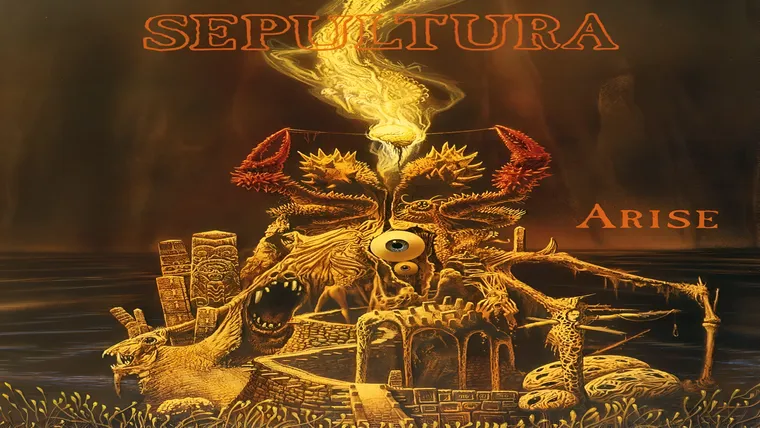Released on March 25, 1991, Arise marked a defining moment in Sepultura’s career, solidifying them as one of the most important forces in extreme metal. With its blistering speed, razor-sharp riffs, and brutal intensity, the album saw the Brazilian metal titans perfecting their blend of thrash and death metal while incorporating hints of the experimental direction they would later embrace.
Unlike many of their thrash contemporaries, Sepultura’s sound carried an unmistakable rawness and aggression, setting Arise apart as one of the most ferocious and uncompromising metal albums of its era.
By the early ‘90s, thrash metal was at a crossroads. The genre’s golden age had peaked, with Metallica moving toward a more commercial sound and Slayer reaching their creative zenith with Seasons in the Abyss. Meanwhile, death metal was on the rise, with bands like Death and Morbid Angel pushing the boundaries of heaviness. Amidst this shifting landscape, Sepultura carved out their own niche—a sound that was as fast and technical as thrash but carried the primal brutality of death metal.
By the time Arise was recorded, Sepultura had solidified a lineup that would become legendary: Max Cavalera on vocals and rhythm guitar, Andreas Kisser on lead guitar, Paulo Jr. on bass, and Igor Cavalera on drums. Having already made waves with Beneath the Remains, the band entered the studio with newfound confidence and a clear vision—to create the most extreme, aggressive, and technically precise album of their career.
Max Cavalera’s riffing was sharper than ever, delivering relentless, chugging assaults that gave the album its crushing foundation. Andreas Kisser’s lead guitar work added layers of chaos and melody, while Paulo Jr.’s bass provided a thick, driving low end. Holding everything together was Igor Cavalera, whose drumming was both ferocious and precise, seamlessly shifting between lightning-fast thrash beats and punishing groove-driven rhythms.
Vocally, Max Cavalera delivered some of his most intense performances to date. His raw, guttural style struck the perfect balance between thrash aggression and death metal ferocity, making every lyric sound like a battle cry. The apocalyptic themes of the album—war, corruption, and destruction—only added to the sheer force of his delivery.
Reflecting on the band’s mindset at the time, Max Cavalera once said:
“We wanted to push everything to the limit—faster, heavier, more aggressive. We were young and hungry, and Arise was us proving to the world that we could hang with the best in metal.”
That hunger is evident throughout Arise. From the very first moments of the title track, the album is an all-out assault. Blistering speed, crushing grooves, and razor-sharp precision make it impossible to ignore.
What truly sets Arise apart from its predecessors is its evolving sense of atmosphere and experimentation. While Beneath the Remains was pure thrash fury, Arise introduced subtle industrial elements, eerie acoustic passages, and darker, more apocalyptic textures. Songs like “Dead Embryonic Cells” showcased a more dynamic approach, blending breakneck thrash with mid-tempo grooves and eerie melodies, foreshadowing the tribal influences Sepultura would later explore.
Even in its most brutal moments, the album never loses its sense of precision and purpose. Tracks like “Desperate Cry” and “Altered State” slow things down just enough to let the crushing weight of the riffs sink in, while “Under Siege (Regnum Irae)” hints at the band’s growing interest in atmospheric soundscapes. The result is an album that’s as varied as it is punishing—a testament to Sepultura’s ability to evolve without losing their edge.
Reflecting on the album’s significance, Andreas Kisser said:
“With Arise, we found our sound. We weren’t just another thrash band—we were something heavier, something different. It was a turning point for us, and for metal.”
This philosophy is what makes Arise one of the greatest extreme metal albums of all time. It had all the speed and aggression of classic thrash but carried the unrelenting brutality that would influence death metal and groove metal for years to come.
Produced by Scott Burns, who had already cemented himself as one of the top producers in death metal with his work on albums by Death, Obituary, and Morbid Angel, Arise benefited from a crushing yet clear production. The guitars were sharper, the drums more punishing, and the overall mix more powerful than anything Sepultura had released before. This sonic clarity helped the album’s precision and intensity hit even harder.
Upon its release, Arise was met with widespread acclaim, earning Sepultura their first taste of mainstream recognition while maintaining their underground credibility. It became their first album to go gold, expanding their reach beyond Brazil and into the global metal scene. It also set the stage for their future experimentation, paving the way for the tribal rhythms and groove-heavy direction of Chaos A.D. and Roots.
Decades later, the influence of Arise remains undeniable. Many bands, from death metal pioneers to modern groove metal giants, cite it as a key inspiration. Its songs remain staples of Sepultura’s live performances, still igniting pits and sending fans into a frenzy. Even as extreme metal has evolved, Arise remains a benchmark for how to create an album that is both technically masterful and devastatingly heavy.
Reflecting on its lasting impact, Igor Cavalera said:
“We had no idea at the time how important Arise would become. We were just writing the heaviest, fastest music we could—but somehow, it became something bigger than us.”
Final Verdict: 9.5/10
Standout Tracks:
- “Arise”
- “Dead Embryonic Cells”
- “Desperate Cry”
- “Under Siege (Regnum Irae)”
- “Altered State”
- “Meaningless Movements”
Arise isn’t just one of Sepultura’s greatest albums—it’s one of the defining albums of extreme metal. With its relentless speed, apocalyptic intensity, and forward-thinking approach, it remains essential listening for any metal fan.
Whether you’re experiencing it for the first time or revisiting it years later, Arise stands as a testament to Sepultura’s ability to push metal to its absolute limits.
Until next time, play it loud, friends!

